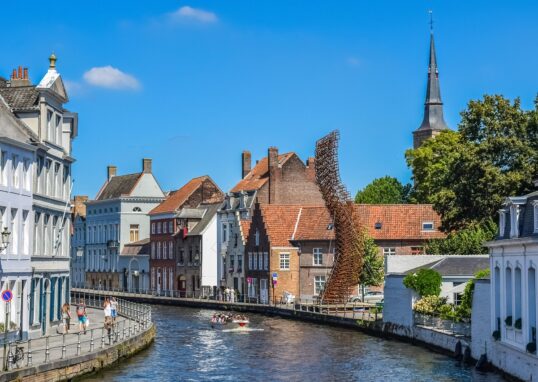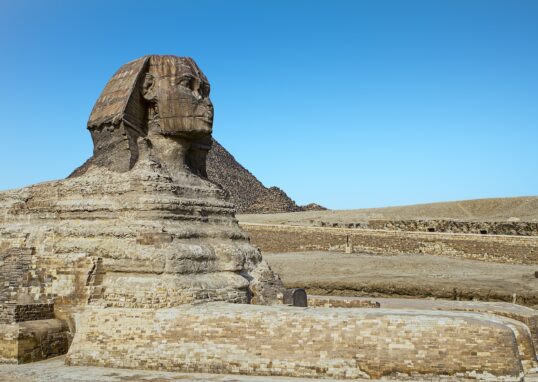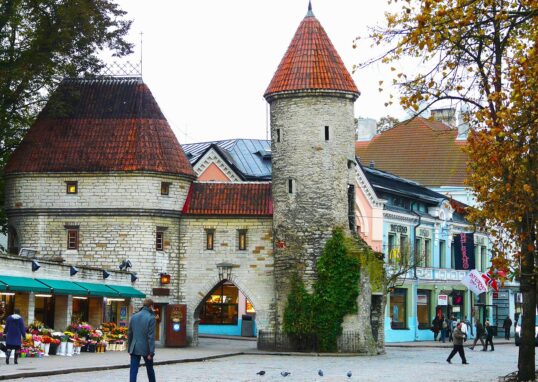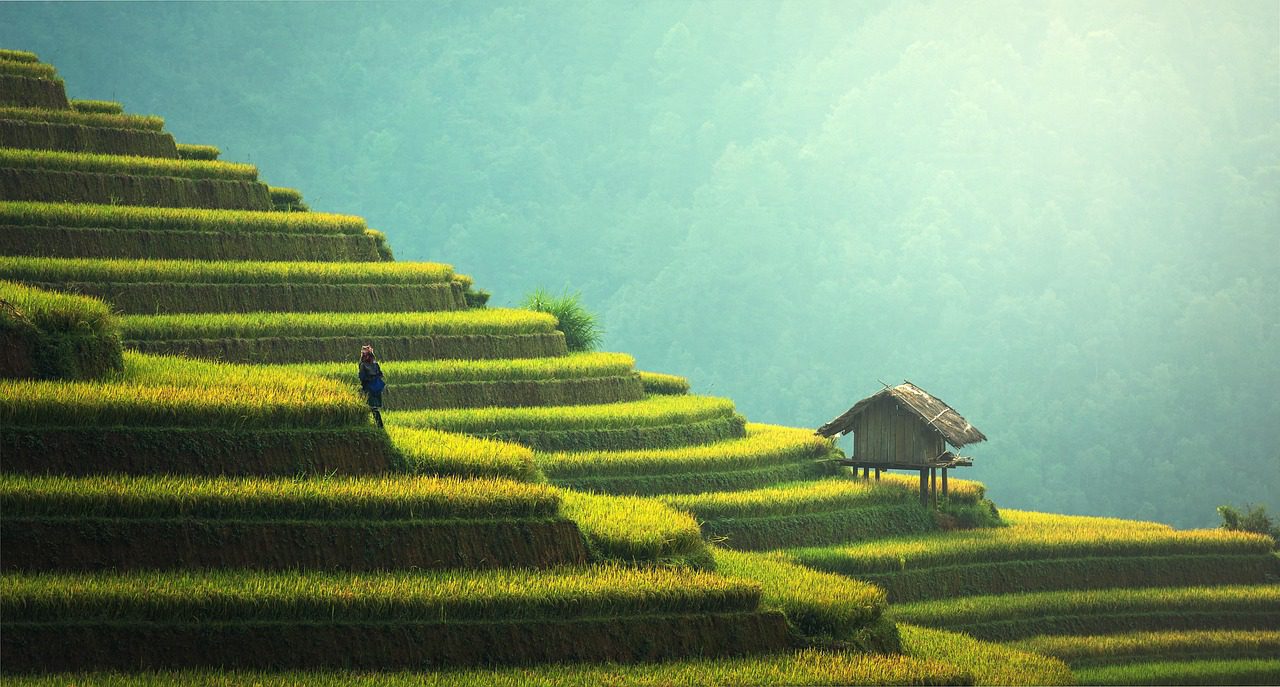
The Honghe Hani Rice Terraces: A Living Work of Art in China
The Honghe Hani Rice Terraces represent one of the most beautiful agricultural landscapes in the world. Situated in the southern part of Yunnan Province in China and lying next to the Red River, also called the Honghe River, they cover the Ailao Mountains, where the Hani ethnic people reside and have been farming for over 1,300 years. This is not only a wonder of farming but also a masterpiece of human harmony with nature. Every terrace, pond, forest, and village all goes well together like a picture. Rice terraces are just perfect examples of how human beings can live with nature. Due to this, UNESCO enlisted the Honghe Hani Rice Terraces in the World Heritage List in 2013. 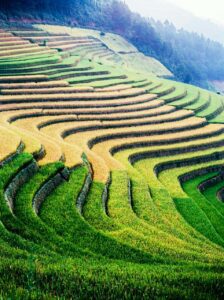
Location and Geography
These are mainly found in Yuanyang County, part of Honghe Hani and Yi Autonomous Prefecture. This region is located in the south of Yunnan Province and is close to the borders with Vietnam and Laos. The terraces stretch out over more than 45,000 hectares, therefore composing one of the largest rice terrace systems in the world. Honghe is an area dominated by mountains, deep valleys, and waterways. The terraces cling to southern slopes in the Ailao Mountains, which stretch between 1,000 and 2,000 meters above sea level. When viewed from afar, terraces look like steps climbing the mountains, shining with water and reflecting the sky.
History and Cultural Background
The Honghe Hani Rice Terraces are bound up with the history of the Hani people, one of China’s 56 ethnic groups. More than a thousand years ago, the Hani migrated into this area and carved the mountains into rice terraces in order to grow food. They had ingeniously developed a natural water-terracing farm system. The catchments at mountain tops catch rainwater: this is then channeled, through streams and bamboo pipes, down into the terraces below. Water is stored in the terraces and is distributed with care among the fields. Eventually, at the very lowest levels, the water finally finds its way into rivers. This water system supports rice and fish and helps locals survive. This type of farming methodology has been passed from generation to generation among the Hani people. Their system pays due respect to nature and collective co-operation. 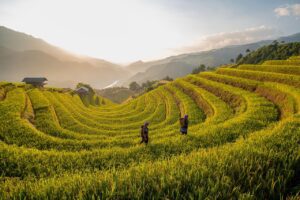
Design and Structure of the Terraces
There are four main layers to the Honghe Hani Rice Terraces: the forest, the village, the terraces, and the river. These are natural and cultural components which interact together.
- The forest layer is at the top of the mountains, keeping the water clean and feeding the irrigation system.
- The village layer covers the area just below the forest. The Hani people build their houses here, close by to a water source, but above the terraces.
- Below the villages, there exists a terrace layer. Hundreds of steps are carved into the mountain. Every terrace is full of water and rice plants.
- The river layer is the bottom layer. The extra water of the terraces collects in the river.
This structure forms a balanced ecosystem wherein birds, fish, and insects can be found in the terraces, while the forests shelter wild animals and yield materials for daily life. The color of the terraces also changes with the seasons: in spring, they are full of water and shine like mirrors; in summer, they grow green with rice; in autumn, they turn golden as the rice ripens; and in winter, mist and clouds cover them, adding a dreamy haze.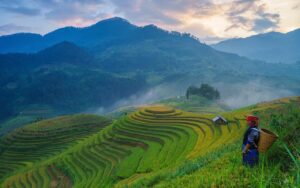
Villages and Local Life
There are about 82 villages scattered over the terrace area. The most famous among these include Duoyishu, Bada, Laohuzui, and Pugao Laozhai. Most of them are built on the hillsides, leaning against the fields and forests. Traditional Hani houses are mushroom-shaped, built with earth and wood. The walls are thick to keep the inside warm in winter and cool in summer. The roof consists of thatch or tiles. It usually consists of two floors: animals are kept below, and people live above. Women are usually seen in bright finery embroidered and adorned with silver. Music and dance are an inseparable part of their day-to-day culture, evoking their strong attachment to nature and people around them.
Farming and Irrigation System
The Honghe Hani Rice Terraces are one of the most remarkable farming systems that embody sustainable agriculture. It relies on natural water flow down the mountain. Rainwater is collected in the forests, then moves down through channels and streams until it reaches the terraces. Each family has its share of the water. The villagers follow traditional rules in order not to waste or pollute the water. It is this cooperation among the community that keeps the system going for centuries. The terraces are planted with red rice, which does well in a mountain climate; farmers also raise fish and ducks on the flooded terraces. This provides a natural balance-fish eat insects, ducks stir the mud, and their waste helps fertilize the soil.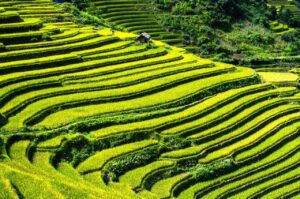
Beauty Through the Seasons
Beautiful all year round, the Honghe Hani Rice Terraces represent each season in a different way.
- In spring, from January to March: Water fills the terraces, creating a mirror effect with the reflection of the sky. Photographers from around the world make their way to capture the shining terraces at sunrise.
- In summer, from April to August, the rice grows and the terraces wear a green attire. Farmers go out to the fields, and the mountains wear a colorful outlook.
- During autumn, from September to November, the ripened rice turns golden yellow and the terraces become a beautiful sight. This is a season of joy and festivities.
- In winter (December): The mountains become misty and cloudy. The terraces take on the appearance of a silver ribbon in the fog.
The scenery is ever-changing, attracting many travelers, photographers, and nature lovers. Many people say it feels like walking inside a living painting.
Cultural and Spiritual Beliefs
The Hani people believe that everything in nature has a spirit. They respect the forests, the mountains, and the water. Ceremonies paying respects to the Water God and the Mountain Spirit are held annually. This reflects gratitude for the blessings of nature. Their traditional beliefs held that in nature, a balance must be created between people and nature. The forest cannot be cut too much. The water cannot be polluted. The community must share and protect the land. These beliefs have helped keep the terraces sustainable for more than a thousand years.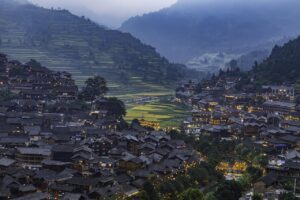
Tourism and Modern Development
In the Honghe region, tourism has developed rapidly in recent years. Tourists flock to see the terraces, villages, and to learn about local life. Yuanyang has gradually turned into a popular ecological tourist and photography destination. A number of viewpoints have been constructed such as Duoyishu Sunrise Point, Bada Scenic Area, and Laohuzui (Tiger Mouth) that afford spectacular views over the terraces at times of sunrise and sunset. Small guesthouses and eco-hotels are springing up; several are family-run operations. Visitors can be housed in traditional-style dwellings, sample local food, and take in cultural performances. Tourism brings money in, but with it also come problems of pollution and overcrowding. Local authorities work to keep a balance between tourism and conservation.
Challenges and Conservation
Though beautiful, there are some problems faced by the terraces. Sometimes, young people move to cities, which means leaving the terraces uncultivated. The recent climate change alters rainfall and temperature patterns. When water becomes scarce, farming will suffer. Now, the government and local groups are taking steps in preserving the terraces.
🌾 Surrounding Places of the Honghe Hani Rice Terraces
The Honghe Hani Rice Terraces are situated in the southern part of Yunnan Province, China, within the Honghe Hani and Yi Autonomous Prefecture.
While the terraces themselves are the main attraction, the surroundings also boast many wonderful and culturally rich places.
Duoyishu Village
Duoyishu is one of the most famous villages in the Honghe terrace area and is best known for its sunrise view. Visitors start to arrive at the Duoyishu Viewing Platform early in the morning. When the sun rises, the sky turns red and orange, and the light is reflected by water on each terrace. It is a magical moment, bringing photographers from all over the world. It is a small, quiet village where wooden houses, lining narrow paths with treetops and fields, stand. The locals greet warmly. You can walk down to the terraces and see farmers planting or harvesting rice by hand. Mist covers the valley in the evenings, turning it into a dreamland. The sound of birds chirping and gushing water enhances the beauty.
Bada Scenic Area
Bada is another great place to see the rice terraces. It is famous for its sunset view. During the time of sunset, when the sun goes down, the color of the terraces reflects red, gold, and pink. The reflection of light on hundreds of terraces looks like a painting. Larger terraces spreading wide across the hills can also be found in the Bada area. The shapes and patterns of the terraces are very artistic. There are small viewpoints around where one can sit and enjoy the view. Some families run guesthouses near Bada. Visitors can stay overnight to taste homemade Hani food and experience rural life. You can also join farmers and try planting rice for fun — a wonderful cultural experience.
Laohuzui (Tiger Mouth)
Laohuzui means “Tiger Mouth.” It is named because the terraces look like the open mouth of a tiger when viewed from above. It is one of the most dramatic and steep parts of the terrace landscape.
Laohuzui Viewpoint provides a clear view of the valley in its entirety. Terraces herein are deep and curved, reflecting the skill of the Hani farmers. It is equally beautiful at sunset, but the highlight of the place is the patterns of the terraces. There are small pathways for visitors to walk down into the terraces, meet farmers, and witness how they manage the water system. At planting time, the fields glitter like a silver mirror; at harvest time, they glow like gold.
Pugao Laozhai Village
Pugao Laozhai, a small village surrounded by thick forests and small lakes, is less crowded but perfect for travelers who love peace and nature. The village is built on a steep hillside, with narrow stone paths connecting the houses. From the top of the village, you can see the Duoyishu Terraces in the distance. It is especially beautiful early morning when clouds rise from the valley.
The people here still follow ancient customs; they sing traditional Hani songs and celebrate festivals with dances and food. The Pugao Laozhai also provides guesthouses where visitors can stay for the night and taste local tea, rice wine, and home-cooked dishes.
Jianshui Ancient Town
Jianshui is situated about 90 kilometers north of Yuanyang, and it is one of the oldest towns in Yunnan. Indeed, it has over 1,200 years of history, and it is famous for beautiful architecture, bridges, and temples. Its streets are lined with well-preserved traditional houses, courtyards, and stone gates. The Chaoyang Tower, which was built during the Ming Dynasty, is one of the town’s most famous landmarks. Another attraction is the Zhu Family Garden, featuring a large private residence with over 200 rooms and 40 courtyards that reflect the refined life of a rich Chinese family many centuries ago.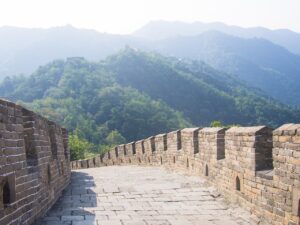
Kunming – The City of Eternal Spring
About 300 kilometers away from Yuanyang lies Kunming, the capital of Yunnan Province. Known as the “City of Eternal Spring,” Kunming enjoys mild weather throughout the year. It forms the starting point for most travelers visiting the Honghe Hani Rice Terraces.
In Kunming, there are many beautiful attractions:
- It is home to the Stone Forest, a UNESCO World Heritage Site of tall limestone rocks shaped like trees and animals. Green Lake Park: A quiet place to walk, boat, and look at seagulls in the winter. Yunnan Nationalities Village shows the existence of 26 ethnic groups within the province.
Jianshui to Yuanyang Route
The road from Jianshui to Yuanyang is full of scenic beauty. It winds through hills, rivers, and small ethnic villages. You can stop at local tea shops, fruit stalls, and temples along the way. This drive is worth it, with beautiful views of the Red River Valley and the green countryside of southern Yunnan.
Red River (Honghe) Valley
The rice terraces get their names from the Red River (Honghe) passing below the terraces. This river originates in Yunnan and flows into Vietnam, where it empties into the Gulf of Tonkin. It supports farmlands, forests, and many villages. The river is important to the economy of the region: it provides irrigation, supports fishing, and its valley is full of biodiversity, housing birds, butterflies, and plants found nowhere else.
Xishuangbanna Rainforest
A bit farther south of Honghe is Xishuangbanna, close to the borders with Laos and Myanmar. This is a tropical region with warm weather and green rainforests. You will find elephants, monkeys, and hundreds of species of birds here. More famous, perhaps, is the traditional Dai ethnic minority group of Xishuangbanna with their Water Festival and traditional stilt houses. A beautiful contrast to the mountain world of the Hani people. Travelers often visit the two places to experience Yunnan’s diversity: from cool mountain terraces to warm tropical jungles.
Luchun and Jinping Counties
Close to Yuanyang, there are Luchun and Jinping Counties. These areas have terraces and ethnic villages as well. Although they aren’t as renowned as Yuanyang, they are just as beautiful. You can find small Hani, Yi, and Miao communities that live in colorful wooden houses. These are ideal sites for a traveler who likes being off the beaten track. There is clean air, serene scenery, and plenty of friendly people.
Dali and Lijiang
Farther north, within the same province of Yunnan, are the famous ancient towns of Dali and Lijiang. They are both UNESCO World Heritage Sites due to the presence of old architecture and natural surroundings. In Dali, the Erhai Lake and Cangshan Mountains have beautiful scenery. In Lijiang, there is an Old Town containing cobblestone streets, canals, and wood bridges. Although they are several hours away, many travelers include them in their Yunnan tour following a visit to Honghe.
Conclusion
The Honghe Hani Rice Terraces are far more than farmlands; they represent living art, a sign of human creativity, and a proof that people can live with nature in peace. The terraces, villages, and forests serve to emphasize how something timeless could be built from the knowledge and cooperation of ancient times. You feel the connection between human beings and the Earth while walking alongside the terraces. The reflection of the sky in the water reflects that nature provides for everything, should one care for it. The Honghe Hani Rice Terraces are a treasure not just of China but also of the world, for this is where history, culture, and nature all come into perfect harmony.


